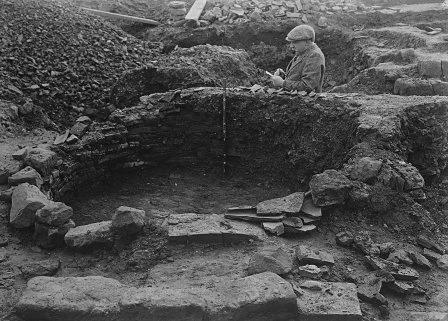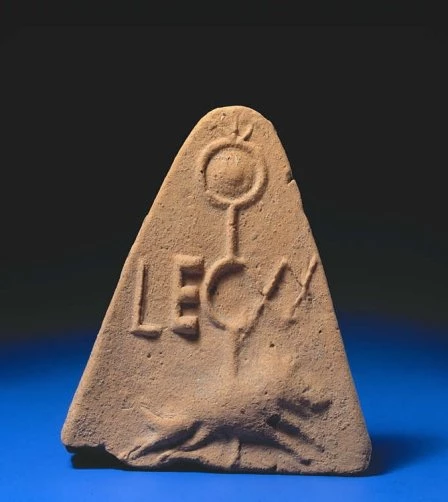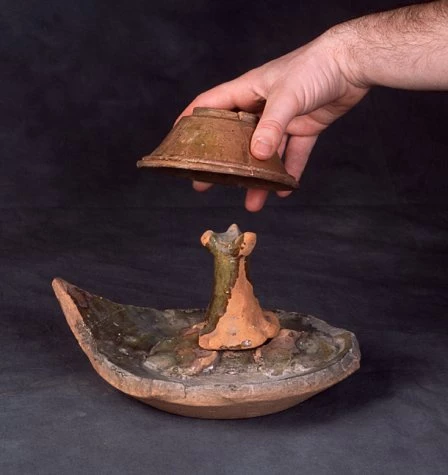Roman glazed pottery from North Wales
Green glazed pottery from Holt (Wrexham).
Excavations at Holt before the First World War. In this photograph Mr Acton stands beside the remains of one of the pottery kilns he discovered.
This ceramic plaque (known as an antefix) was used to cover the end of a line of roof tiles. It was produced at Holt and bears the stamp of the 20th Legion (LEG XX), as well as their emblem (a wild boar), and a standard.
Illustration of how green glazed vessels were fired.
Shortly after the Roman conquest, potters in North Wales were using a technology first developed in Egypt in the 1st millennium BC.
Holt, near Wrexham, North Wales produced pottery and building materials for the legionary fortress at Chester. The main period of production at Holt appears to have been between AD87 and AD135 - when the fort at Chester was rebuilt. However, production probably continued into the 3rd century AD.
Holt specialized in a number of different shapes and styles of pottery, some of which show a remarkable degree of technological sophistication on the part of the potters - none more so than the Green Glazed ware.
Glazed wares of any type are difficult to produce and are rare in Britain prior to the medieval period, however, limited numbers of vessels were produced at Holt and at Caerleon in the Roman period. They were made by dipping a vessel into a 'frit' (a raw glaze suspended in water). In the Roman world this frit was normally based on a lead oxide.
When the vessel was fired this reacted with silica in the pot, to form a hard impermeable glazed surface that can range in colour from light yellow to olive green to dark brown.
During the firing the Holt potters would have faced two major problems.
First, during the firing, the glaze liquifies and, if over-heated, could run excessively; if this happened the pots could become fused together. Second, hot, dirty gases in the kiln could affect the chemical reaction and cause blisters to the glaze or change its colour.
The Holt potters overcame these problems by firing their pots on a prop set within a 'saggar' (a fired clay box). A lid sealed the top of the saggar, keeping the vessel inside protected from the kiln gases and running glaze from other pots.
The technology to produce glazed pots in this way was developed in the Near East and Egypt during the early first millennium BC and was not known in Britain prior to the arrival of the Romans.
Presumably it was introduced at Holt to enable the soldiers to continue to enjoy luxuries they had grown familiar with elsewhere in the empire.
Background Reading
'A collection of samian from the legionary works-depot at Holt' by M. Ward. In Form and Fabric: Studies in Rome's material past in honour of B. R. Hartley by J. Bird, p133-43. Published by Oxbow Books (1998).
'Holt, Denbighshire: the works depot of the twentieth Legion at Castle Lyons' by W. F. Grimes. In Y Cymmrodor, vol. 41. Published by The Society of Cymmrodorion (1930).
'The Lead Glazed Wares of Roman Britain' by P. Arthur. In Early Fine Wares in Roman Britain by P. Arthur and G. Marsh, p293-356. Published by British Archaeological Reports (1978).




Comments - (4)
Hi there Don, just to update - I will contact you via email so that our curators can have a look at any photographs which you might have, and help with identification.
Best
Sara
Digital Team
Hi there Don
Thanks for your enquiry - I will pass it on to the curator responsible, and post their answer here as soon as I get it.
Best
Sara
Digital Team
I have been frustrated by green and green/brown glazed pottery sherds for years as it is always dismissed as medieval or later.
This has resulted in much of the material being discarded.
I have a number of glazed sherds from reasonably secure contexts with 1st C grey wares and BB sherds associated with 1st century Roman iron working furnaces at Littledean, Glos.
Now I have read about glazed pottery in North Wales and Caerleon I can really see no alternative than these sherds being Roman.
The fabric is generally typical Severn Valley or cream to white.
Can you give me any advice on determining Roman over Medieval?
Any advice would be welcome!!
Best wishes
Don Macer-Wright